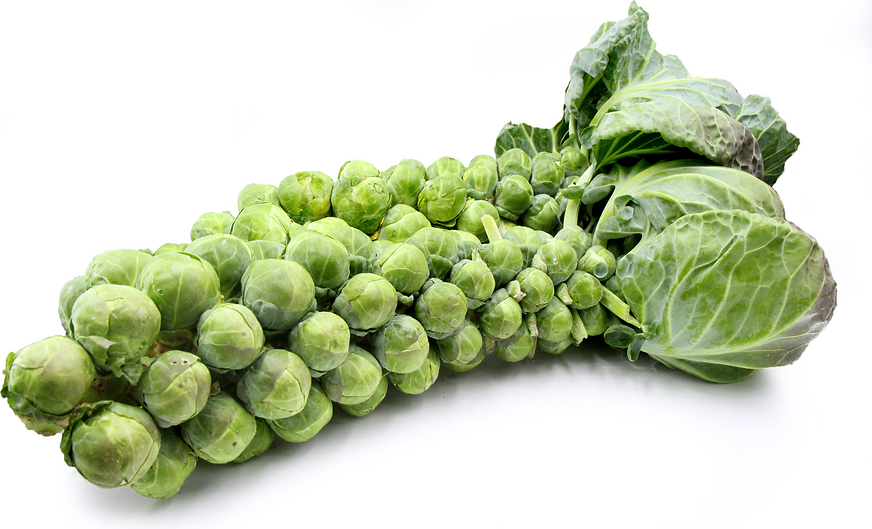


Brussels Sprouts Stalk
Estimated Inventory, ea : 0
Description/Taste
Brussels sprout stalks are the edible stems that round, bulbous sprouts grow on. These stalks are thick and large, measuring around 60 centimeters long, and provide a source of post-harvest nutrients for the sprouts, allowing them to retain their livelihood and moisture longer. The sprouts that grow on these stalks consist of compact, rounded leaves tightly bound into individual, spherical heads that range from about 2.5 to 5 centimeters in diameter when mature. They grow in a spiral pattern around each stalk and can be harvested individually or eaten along with the stalk. Their leaves range in color from sea green to fern green, with some varieties featuring blushed violet-red tips. Their flavor contains notes of grass and raw nuts along with a cruciferous bittersweetness. Younger Brussels sprout stalks carry a sweeter, more palatable flavor than more mature ones.
Seasons/Availability
Brussels sprout stalks are available from late summer to winter.
Current Facts
Brussels sprout stalks are botanically known as Brassica oleracea and belong to Brassicaceae family. They are the axillary buds of the plant which grow progressively from an upward-sprouting stem. Brassicaceae is an economically important plant family that includes species such as mustard plants, crucifers, and cabbages. Modern cultivars of Brussels sprouts have been developed to remove the bitterness that they're historically associated with. Five common types of Brussels sprouts include Rampart, Content, Oliver, Rowena, and Valiant. Brussels sprout stalks are harvested at the plant's base just above the soil and sold not only for their culinary qualities but also for their ornamental appeal.
Nutritional Value
Brussels sprout stalks are rich in vitamin C, which boosts the immune system, aids in collagen production, and enhances iron absorption. The stalks also provide vitamin K, essential for blood clotting and bone health, and folate, which supports cell division and DNA synthesis. Manganese in Brussels sprout stalks contribute to bone health and metabolic processes, while vitamin B6 aids in brain function, mood regulation, and neurotransmitter production. Their high fiber content promotes digestive health, helps maintain healthy cholesterol levels, and supports weight management. The choline and copper in these stalks are vital for liver function, brain development, iron absorption, and red blood cell formation. The thiamine, potassium, and phosphorus content in Brussels sprout stalks supports energy metabolism, fluid balance, bone health, and nerve and muscle function. The omega-3 fatty acids present in Brussels sprout stalks reduces inflammation and supports heart health.
Applications
Brussels sprout stalks are not often eaten raw because of their distinctly dense texture. They are instead cooked with maple syrup and olive oil, grilled in foil, or glazed with balsamic vinegar. These stalks also bode well for roasting, whether wrapped in bacon or drizzled with honey and lemon. Brussels sprout stalks are complemented by the flavors of apples, almonds, butter, cream, bacon, pecorino, taleggio, and alpine cheeses, garlic, mustard, mushrooms, olive oil, pistachios, pears, pancetta, pepper, pine nuts, thyme, rosemary, and light bodied vinegar. These stalks may be stored in the refrigerator for up to ten days. They can also be propped up in a flower vase and kept at room temperature for 4 to 5 days.
Ethnic/Cultural Info
The tradition of cutting a cross into the base of Brussels sprouts is rooted in historical superstitions. In Medieval Europe, there was a common belief that certain vegetables, including Brussels sprouts, harbored evil spirits or demons within their tightly packed leaves. According to the folklore of the time, these entities could enter the bodies of those who consumed the vegetables, potentially causing illness or misfortune. To protect themselves from such supernatural threats, people would cut a cross into the base of the sprouts before cooking them. This practice was thought to serve as a form of magical warding, a ritual meant to dispel or repel the evil spirits lurking within the vegetable. By marking the sprouts with a cross, it was believed that the spirits would be driven away, rendering the sprouts safe to eat and ensuring that the consumer would be protected from harm.
Geography/History
Brussels sprout stalks are believed to have originated in the Roman Empire and domesticated in 16th century Brussels, Belgium, which they are named after. By the late 18th century, they were being grown in English and French gardens, arrived in the United States in the early 1800s, and reached California by the 1900s. They are a cold hardy plant that thrives in temperate climates with an adequate supply of rainfall and irrigation. This vegetable species is not found in the wild as it was originally bred from wild cabbage and has been domesticated over centuries. Brussels sprout stalks were once primarily grown in home gardens, where the sprouts were removed from the stalks before being sold commercially. Today stalks with sprouts still attached are most likely to be found in specialty stores and farmers' markets.
Recipe Ideas
Recipes that include Brussels Sprouts Stalk. One
| We are not Martha |
|
Beer Batter Fried Brussels Sprouts |
| Kirbie's Cravings |
|
Roasted Spicy Garlic Brussels Sprouts on the Stalk |

















